In this blog you can visit new technology latest news about advance technology viral news latest andriod phones and much more visit this blog for more updates daily thanks
Sunday, 3 June 2018
Saturday, 2 June 2018
Looks like macOS 10.14 will have a new dark mode and an Apple News app
Apple’s Worldwide Developers Conference is just a couple of days away, but some of the updates appear to have been revealed early.
Specifically, developer Steve Troughton-Smith tweeted some screenshots this morning of what he said was macOS 10.14. And while the screenshots focused on Xcode 10, they also revealed a couple of bigger changes to the operating system.
For one thing, it looks like the new version of macOS will include a more comprehensive dark mode — one that doesn’t just darken the menu bar and the dock, but applies much more broadly, affecting apps and even the Trash can. The screenshots also include an icon for Apple News in the dock, so there’s probably a new desktop version of the app on the way.
Ladies and gentlemen, I give you Xcode 10 on macOS 10.14. Dark Appearance, Apple News, App Store w/ video previews pic.twitter.com/rJlDy81W4W
— Steve Troughton-Smith (@stroughtonsmith) June 2, 2018
How did Troughton-Smith get ahold of these screenshots? He said Apple posted a preview video for Xcode to the Mac App Store API — a video he then shared with 9to5Mac. So it seems the Mac App Store will start include preview videos like this one (the iOS App Store already does).
Ahead of WWDC, there have been rumors that Apple will launch “universal” apps that work on both desktop and mobile. Nothing here confirms that, but it does suggest Apple is working to make iOS and macOS — and their respective App Stores — more similar.
from Apple – TechCrunch https://ift.tt/2xBgd97
Friday, 1 June 2018
Patient reporting tool from CancerAid now integrates with Epic Systems and Apple HealthKit
CancerAid, a self-reporting and symptom monitoring tool for cancer patients, has scored its first major coup in the U.S. healthcare market with its integration into Epic Systems electronic health records at Cedars Sinai in Los Angeles and an integration with Apple’s HealthKit.
Cedars, an investor in the company through an accelerator program it ran in conjunction with Techstars, marks the first U.S. hospital system to incorporate CancerAid’s self-reporting information into a dashboard system for doctors.
It’s been a long road for company co-founders Raghav Murali-Ganesh and Nikhil Pooviah, who first met eight years ago at the Chris O’Brien Lifehouse, a Sydney, Australia cancer treatment center.
Pooviah was a resident working with Murali-Ganesh in radiation oncology, positions the two men occupied for several years before venturing off on their own to launch the service that would become CancerAid.
The company’s initial inspiration came from years spent checking out the tools that were already in the market for cancer patients — tools like Chemo Calendar that helped with things like scheduling and monitoring appointments.
Instead of studying for some particularly tricky upcoming exams, Pooviah was spending time developing a patient-facing self-reporting symptom tracker and a community portal for cancer patients to discuss, share and monitor their own symptoms.

CancerAid co-founders Drs. Nikhil Pooviah and Raghav Murali-Ganesh and Martin Seneviratne
It was that first tool that won the company acceptance into the Cedars Sinai accelerator and a competitive position in TechCrunch’s inaugural Startup Battlefield competition in Sydney, Australia.
From its initial development, CancerAid now has four primary functions. On the patient side, there’s personalized cancer information for patients after their initial diagnosis. The company also provides a personal journal and symptom journal for patients to report on how they’re feeling, both emotionally and physically, as they progress through their treatment.
A feature the company calls “Champions” was added so that family and friends could keep up with patients and encourage them. And finally, the company added a social networking feature so patients could connect with a broader community of patients and survivors.
Now, the company has added “ClinicianLink,” a clinician-facing dashboard that sits in Epic and integrates with the existing workflows of nurses, oncologists, radiologists and the rest of the hospital administration and operational staff that touches patients as they undergo treatment.
The company expects to lock in six-figure licensing deals for hospital systems to access the entire toolkit and offer it to patients.
For hospitals, there’s some research that suggests simply by reporting their symptoms patients can improve their own outcomes, because doctors have a better sense on more regular intervals of the potential problems their patients face, the company said.
“Patients will be able to use the patient-facing app at home, with a feedback loop back to their care team (physicians, nurses) in the hospital in real-time,” wrote Pooviah in an email. “This feedback loop helps reduce [emergency room] visits and 30 day readmissions (saving $19,000 per patient per year).”
Beyond the Epic integration, CancerAid is also integrating with HealthKit — so that Apple wearables will be able to have the CancerAid functionality, the company said.
The company has 20,000 patients on the app already, and is being used in 80 of the 200 largest U.S. health systems, according to Pooviah.
Backed by $1.9 million in funding from strategic and financial investors, including Cedars-Sinai Health System, Techstars, Australia’s Shark Tank, Slingshot Ventures and Artesian Capital, the company is looking to expand in the U.S. through a dedicated subsidiary as it concentrates on one of the world’s largest healthcare markets.
from Apple – TechCrunch https://ift.tt/2LKXWsO
Apple Pay tests ‘order ahead’ for drinks at music festivals
Apple is fixing one of the worst parts of the concert experience: waiting in line for a beer while you miss your favorite song. Last week’s BottleRock music festival near San Francisco was the first to try a new ‘order ahead with Apple Pay’ feature that Apple hopes to bring to more events. You just open the festival’s app, select the closest concession stand, choose your drinks, Apple Pay with your face or fingerprint, and pick up the beverages at a dedicated window with no queue.
Check out our demo video below.
BottleRock’s upscale wine & oldies music fest, 100 miles from the tech giant’s headquarters, has become a testbed for Apple Pay. Last year, every concession stand got equipped with the Square’s Apple Pay-ready point of sale system and special fast lanes for customers who used it instead of cash or credit card. 30% of all transactions at BottleRock were made with Apple Pay, according to an Apple spokesperson, proving people wanted a faster way to get back to the show.
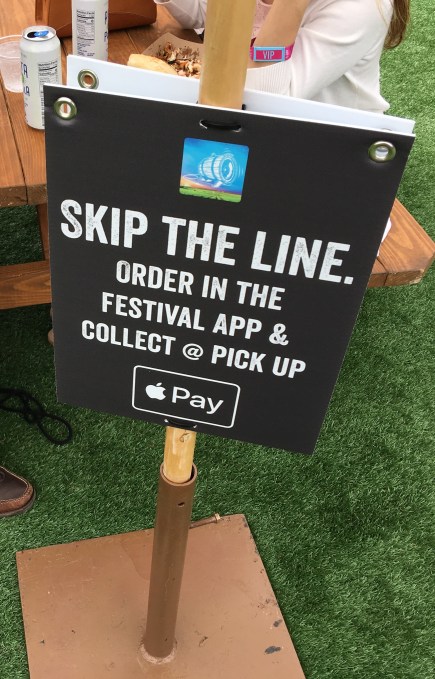
With order ahead, your drinks are ready for pick up so you don’t even have to break your dance stride. Having gone to 14 Coachellas, I’d learned to forego booze rather than risk losing my friends or a chance to hear that hit single while stewing in the beer garden lines. But Apple Pay powered the best concert commerce experience I’ve had yet. I’m sure I’m not the only one who knocked back a few more drinks last weekend because it was so convenient.
That’s why I foresee music festivals jumping at the chance to integrate order ahead with Apple Pay into their apps. They and their vendors will see more sales, while attendees see more music. Meanwhile, it’s a smart way for Apple to reach a juicy demographic. Apple Pay is especially helpful when you’re in a rush, but festival goers will return home more likely to use it day-to-day.
Often times, music festival tech like friend finding apps and location-based alerts can interrupt the moment. Apple Pay succeeds here by fading away, keeping you in harmony with the present.
from Apple – TechCrunch https://ift.tt/2J91AuI
Apple to launch its own ‘digital health’ features in iOS 12, says report
At Google I/O in May, the company introduced a series of time management tools for Android users that help better manage screen time, track app usage, and limit the phone’s ability to distract, including a “shush” mode which turns on Do Not Disturb by flipping the phone over, and a “wind down,” color reduction mode for bedtime. Now, it seems Apple will follow suit with its own digital wellbeing features in an upcoming release of the iOS mobile operating system, a new report claims.
According to Bloomberg, Apple will introduce a new set of digital wellbeing features for iOS users at its Worldwide Developer Conference (WWDC) in San Jose on Monday.
The tools will be later released as a part of iOS 12 operating system for iPhone and iPad devices, which typically arrives in the fall.
The report was light on details in terms of which specific metrics Apple will track, but says those details will arrive in a new menu inside the Settings app in iOS 12.
The initiative, called “Digital Health,” will monitor how much time users spend on devices, but it’s unclear if it will also include tools that help users silence their phones using new gestures or settings, or otherwise disengage from their devices.
The digital wellbeing movement is part of a fairly recent course correction for Silicon Valley tech companies, which are now being held accountable for the addictive nature of the devices, apps and services they’ve created.
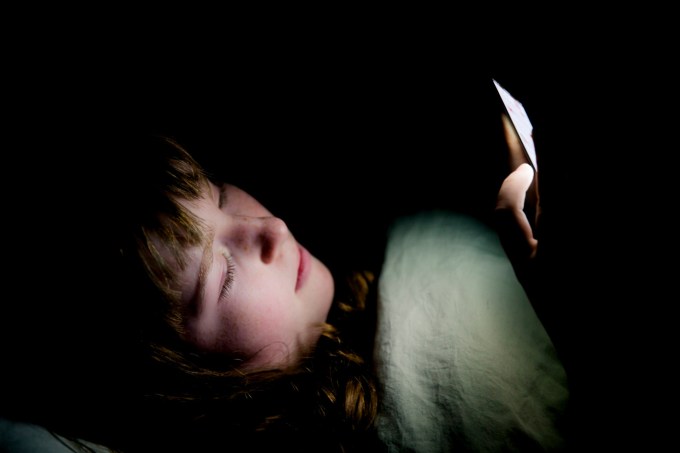
From the beginning, tech company engineers and designers were encouraged to make their products ever more engaging by taking advantage of specific design patterns that prompt regular, addictive usage of their products, and those that increase users’ time spent in apps.
But more recently, some tech execs have come to espouse regrets for what they’ve built. Former Facebook president Sean Parker stated Facebook’s design exploited weakness in the human psyche to addict users, and said he worried about what it was doing to kids’ brains. Meanwhile, former Google exec Tristan Harris launched a coalition of technologists and activists called the Center for Humane Technology, which aims to encourage “humane design” – that is, design that reduces distractions and stress, and keeps people from being hooked on their devices.
Now the industry giants are putting some of these principles into practice.
Facebook earlier this year changed how its News Feed operates to reduce users’ time spent on the site in favor of well-being. Instagram last month introduced its first time well spent feature, by informing users “you’re all caught up” when they’ve viewed all the new posts. Google launched parental control tools in its Family Link service that allow parents to limit kids’ screen time, and introduced the above-mentioned digital wellness features for Android in May.
If Apple were to avoid the topic, it would be the odd one out at this point.
The new digital wellbeing tools will likely be detailed during Monday’s WWDC keynote address, and may include some additional protections for children through an update to iOS’s parental controls. We do know that more robust parental controls are at least coming, as Apple promised this explicitly following criticism from major shareholders about children’s iPhone addiction.
image credit: child on device, Shestock / Getty Images
from Apple – TechCrunch https://ift.tt/2HcGAkV
Thursday, 31 May 2018
The Microsoft Launcher for Android now lets you track your kids’ whereabouts
Microsoft is launching an update to its Android launcher today that gives parents the ability to track their kids’ location. This is one out of a number of parent- and kid-focused announcements the company made today. Others include the ability to block sites in Microsoft Edge on Android and the launch of MSN Kids, a new curated news website for children.
At the core of these new features are Microsoft’s family group settings that already allowed you to do things like track a child’s activity on Windows 10 and Xbox One devices or limit screen time in general.
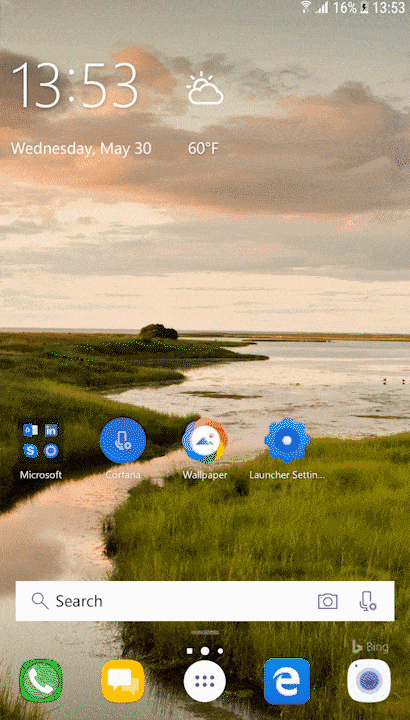 “As a mother to a young and curious daughter, I deeply understand the need for tools to help balance the use of technology in the home as well as out of the home,” writes Shilpa Ranganathan, the General Manager of Microsoft’s Mobile Experiences group, in today’s announcement. “It’s especially near and dear to me as leader of a team building experiences for mobile devices. We emphasize the idea of transparency as a guiding principle for these new experiences.”
“As a mother to a young and curious daughter, I deeply understand the need for tools to help balance the use of technology in the home as well as out of the home,” writes Shilpa Ranganathan, the General Manager of Microsoft’s Mobile Experiences group, in today’s announcement. “It’s especially near and dear to me as leader of a team building experiences for mobile devices. We emphasize the idea of transparency as a guiding principle for these new experiences.”
The new tracking tool is rolling out with today’s update of the Microsoft Launcher for Android and will put the latest known location of your kids right in its personalized news feed.
I’m not sure how useful blocking access to sites in Edge for Android really is, but if you manage to lock your kids out from Chrome or any other pre-installed browser — and block them from downloading them — then I guess this could work.
As for MSN Kids, Microsoft notes that the site will curate information from trusted sources, including Time for Kids, Popular Science, Sports Illustrated for Kids, National Geographic, and USA TODAY. It’s worth noting that there is no sponsored content or advertising on the site.
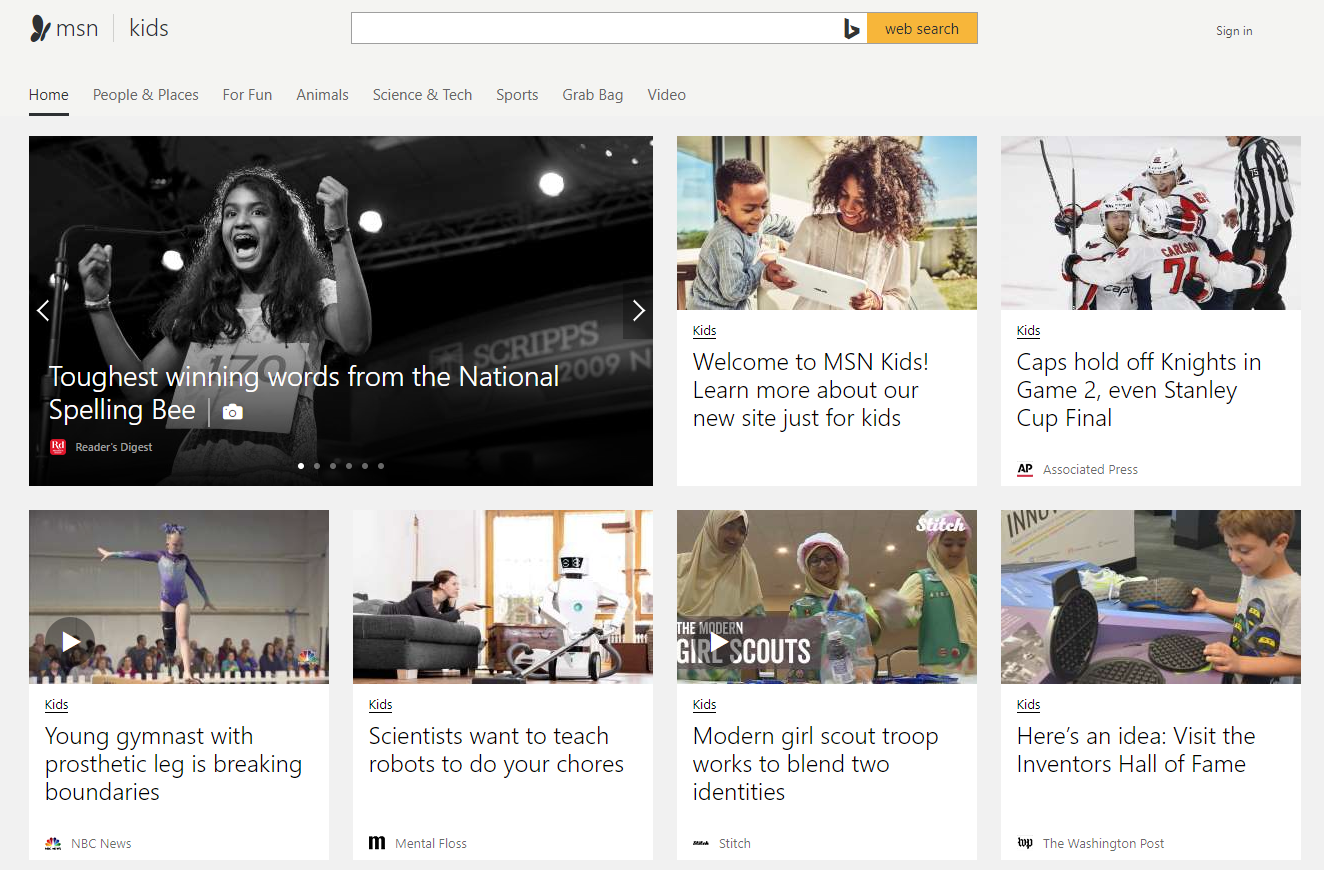
from Android – TechCrunch https://ift.tt/2spksP4
via IFTTT
iOS App Store has seen over 170B downloads, over $130B in revenue since July 2010
The App Store has seen over 170 billion downloads over the past decade, totaling over $130 billion in consumer spend. This data was shared this morning by app intelligence firm App Annie, which is marking the App Store’s 10th Anniversary with a look back on the store’s growth and the larger trends it’s seen. These figures aren’t the full picture, however – the App Store launched on July 10, 2008 with just 500 applications, but App Annie arrived in 2010. The historical data for this report, therefore, goes from July 2010 through December 2017.
That means the true numbers are even higher that what App Annie can confirm.
The report paints a picture of the continued growth of the App Store over the years, noting that iOS App Store revenue growth outpaces downloads, and that nearly doubled between 2015 to 2017.
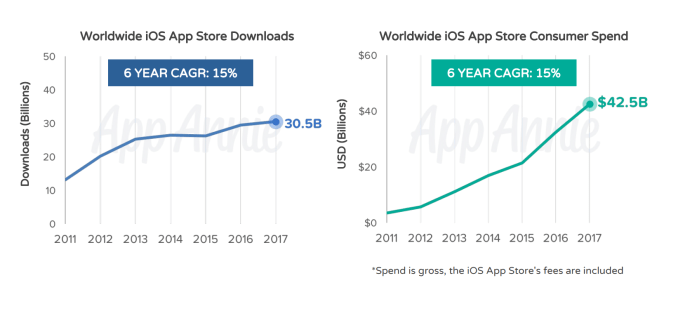
iOS devices owners apparently love to spend on apps, too.
The iOS App Store only has a 30 percent share of worldwide downloads, but accounts for 66 percent of consumer spend, the report says.
But this isn’t a complete picture of the iOS vs. Android battle, as Google Play isn’t available in China. App Annie’s data is incomplete on this front as it’s not accounting for the third-party Android app stores in China.
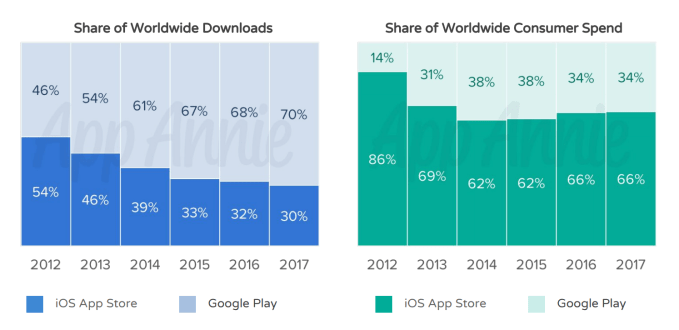
China today plays an outsized role, as App Annie has repeatedly reported, in terms of App Store revenue, even without Google Play. In fact, the APAC region accounts for nearly 60 percent of consumer spend – a trend that began in earnest with the October 2014 release of the iPhone 6 and 6 Plus in China.
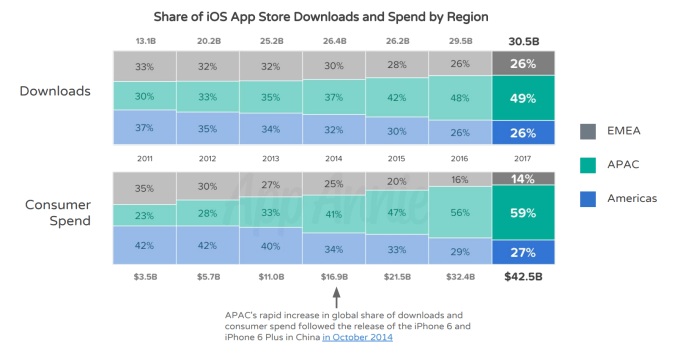
But when you look back at the App Store trends to date (or, as of July 2010 – which is as far back as App Annie’s data goes), it’s the U.S. that leads by a slim margin. China has quickly caught up but the U.S. is still the top country for all-time downloads, with 40.1 billion to China’s 39.9 billion; and it has generated $36 billion in consumer spend to China’s $27.7 billion.
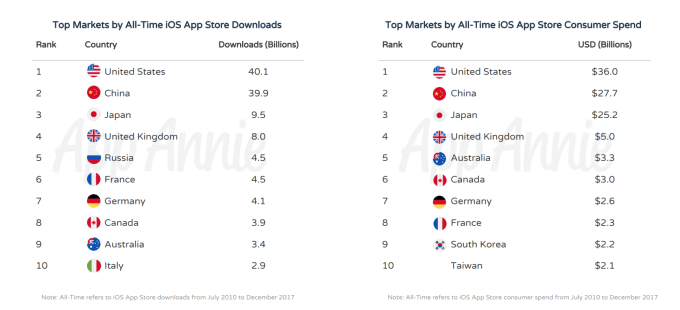
iPhone users are heavy app users, too, the report notes.
In several markets, users have 100 or more apps installed, including Australia, India, China, Germany, Brazil, Japan, South Korea, Indonesia, and France. The U.S., U.K., and Mexico come close, with 96, 90, and 89 average monthly apps installed in 2017, respectively.
Of course the numbers of apps used monthly are much smaller, but still range in the high 30’s to low 40’s, App Annie claims.
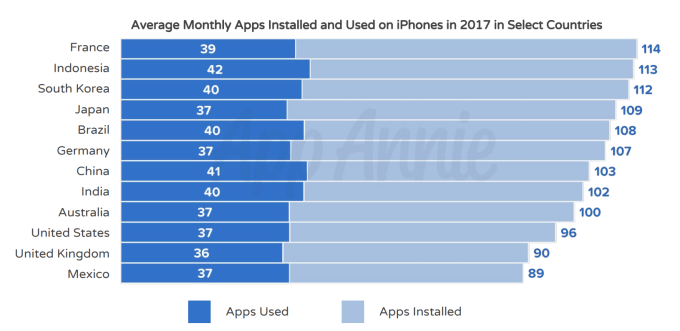
The report additionally examines the impact of games, which accounted for only 31 percent of downloads in 2017, but generated 75 percent of the revenue. The APAC regions plays a large role here as well, with 3.4 billion game downloads last year, and $19.3 billion in consumer spend.
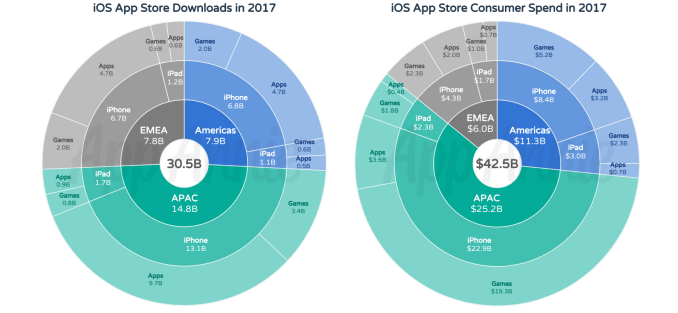
Subscriptions, meanwhile, are a newer trend, but one that’s already boosting App Store revenues considerably, accounting for $10.6 billion in consumer spend in 2017. This is driven mainly by media streaming apps like Netflix, Pandora, and Tencent Video, for example, but Tinder makes a notable showing as one of the top five worldwide apps by revenue.
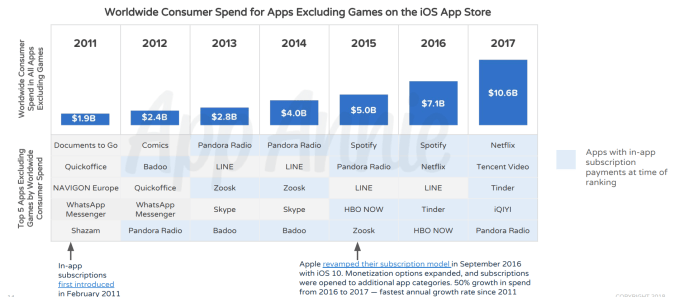
Thanks to subscriptions and other trends, App Annie predicts the worldwide iOS App Store revenue will grow 80 percent from 2017 to $75.7 billion by 2022.
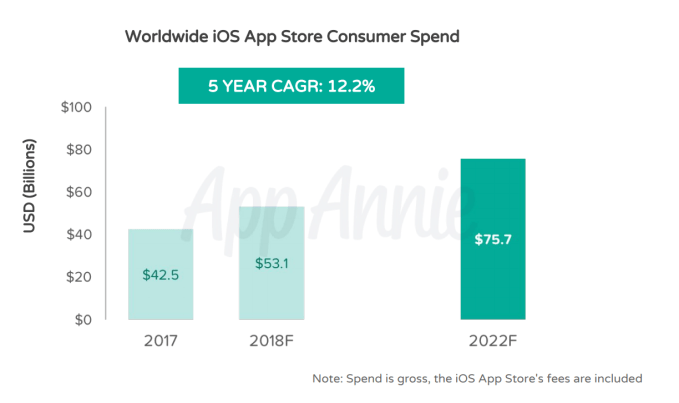
And while the App Store today has over 2 million apps, it has seen over 4.5 million apps released on its store to date. Many of these have been removed by Apple or the developers in the months and years, which is why the number of live apps is so much lower.
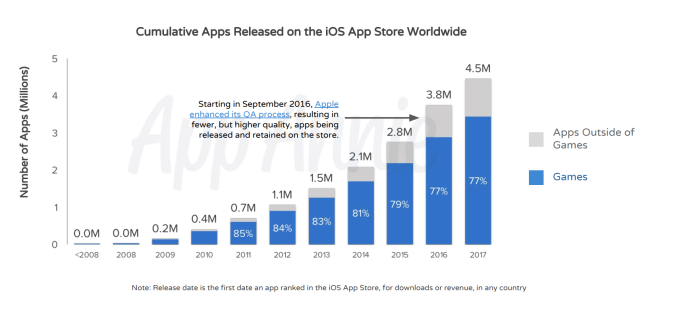
The full report with the charts included is here.
from Apple – TechCrunch https://ift.tt/2slcdnN